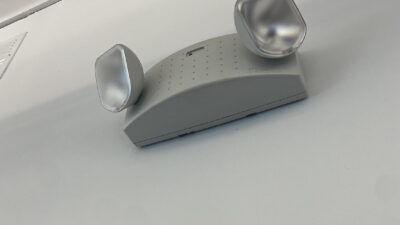As lighting technology continues to evolve, designers and specifiers are faced with the challenge of keeping up with the changes

Lighting control insights
- Lighting controls have evolved significantly over the past 20 years, transitioning from manual switches to programmable, AI-enabled systems.
- Specifying lighting controls has shifted from detailed diagrams to using lighting sequence narratives, reducing designer control but accommodating varying manufacturer approaches.
Lighting controls have seen major changes over the past 20 years and it seems that taking line voltage to a manual switch to control lighting fixtures is a thing of the past. Modern lighting controls are programmable and addressable, connected to either a closed network consisting of relays, power supplies, power packs, sensors and control points.
These systems are “smart” in the way that they offer flexibility for both initial installation as well as flexibility in future revisions, and the next generation of lighting control systems is likely to take advantage of artificial intelligence (AI) for dynamic programming and behavior.
One of the largest changes in this industry is the way lighting controls are specified. Historically, single-line diagrams were used to convey how lighting controls were to be wired and the number of wiring options were fairly limited. There was line voltage, typically 120 volts (V) or 277 V and control voltage, which was usually 0-10 V used for dimming. As digital, programmable lighting control systems became more prevalent, designers started seeing them show up as alternatives during the shop drawing review process. This meant that the manufacturer representatives and suppliers were tasked with developing the wiring diagrams and determining the components required.
As a result, there was a discrepancy between what was specified and what was provided. The primary reason for this difference was the unique way each manufacturer approached lighting control with programmable components. While not intentionally timed, the industry saw a simultaneous shift toward solid state lighting components, now ubiquitously known as LED. Designers were caught scrambling to keep up with rapidly changing technology and the use of detailed wiring diagrams slowly became obsolete.

The most common way for designers to convey the intent of modern lighting controls is with lighting sequence narratives or tables, which describe the system behavior instead of focusing how the system is to be configured. This method is used in lieu of detailed diagrams because the final quantity, arrangement and type of component are now up to the manufacturer and chosen by the construction team, usually determined at time of bid. This new process presents a challenge to designers, as it removes some of their control over the final product and requires a vague specification.
Distributed lighting control
A distributed lighting control system consists of a network of remote modules connected to a digital network via network hubs. Control is managed through either a central station, system server or isolated within each control area. These modules facilitate communication with lighting control devices through the digital network and the system encompasses associated components like wiring, relay modules, photocells, switches, dimmers, time clocks, occupancy sensors, network interfaces and hubs. The system employs distributed relay modules, allowing placement above accessible ceilings, within lighting fixtures themselves or adjacent to the rooms they control, specifically when access is a concern.
Control devices, such as occupancy sensors (including ultrasonic, internal resistance and dual technology types), photocells, switches and timers, are specified by the engineer and shown on the drawings or described within sequences and narratives (see Figure 2). The vendor then chooses which exact products are compatible with the control narrative to operate on the system network. Additional power packs are supplied as necessary, to facilitate multiple control devices, with relevant details identified in shop drawing submissions. It is uncommon for construction documents to include relays on the plans; thus, the supplier is left to determine what components are necessary for system functionality.

The relay modules are mounted in enclosures or on the outside of junction boxes, with a physical separation of 120 to 277 V wiring compartments from low-voltage control wiring. These relay modules offer low-voltage digital communication to control devices as per drawings and schedules, with dimmable relay modules provided when specified. The relays are typically mechanically held and split-coil momentary-pulsed types, rated for 20 amps (A) at 125 V alternating current (ac) for tungsten filaments and 20 A at 277 V ac for electronic ballasts, with a typical rated capacity of 50,000 cycles.
Centralized lighting control
A centralized lighting control system is commonly designed as a network of lighting relay panels integrated into a digital network and managed through a system server or central station. In this system, lighting control devices are connected to the relay panels and communicate with the system server via the panel controller. It encompasses all the necessary components, including network interfaces, wiring, relay panels, control modules, input modules, panel processors, relays, photocells, switches, dimmers, time clocks and occupancy sensors.
To enable seamless communication and coordination, the system includes a server or central station equipped with operating software, a data network and BACnet IP communication capabilities. This ensures compatibility with the building automation system (BAS), like a central controller on a distributed system.
The server or central station allows for programmable operation of lights through the system relays and control devices. The system software facilitates control of relays, control devices, time and sequence scheduling, timed-out and blink light operation and monitoring or reporting of system events and components. Initial programming is set according to the plans and schedules. Designers should coordinate the location of this system and the expected needs with the building owner and operators. Because the operators will want to control schedules and programs, prior experience and proper training are important inclusions in the project specifications.
The system power supplies typically consist of a transformer and full-wave rectifier with filtered direct current output to power the panel, controllers and control devices. Regardless of which type is chosen, the specifier should also consider total harmonic distortion for each type. The system also includes various features to enhance control and operation. The relays are typically mechanically latched, split-coil and momentary-pulsed type. Instead of mechanical relays, the designer can specify a controllable breaker that offers solenoid-operated thermal magnetic breakers to provide control, overload protection and short circuit protection.
Like other system types, the control devices include occupancy sensors, photocells, switches and timers, all designed to operate on the system network. Supplemental power packs are provided for multiple control devices as required.
Digital addressable lighting interface control systems
The digital addressable lighting interface (DALI) control system is designed as a digital lighting control network, connecting DALI-compliant digital addressable ballasts, control modules and lighting control devices directly to a system server or central control station. The individual addressable electronic ballasts, control modules and devices are operated based on signals received through the DALI-compliant bus from various DALI-compliant digital controllers and interfaces. The system software enables control of DALI ballasts, control modules and control devices, as well as time and sequence scheduling, timed-out and blink light operations, monitoring and reporting of system events and components. Designers should identify initial programming on plans and schedules so the manufacturer and system installers can accurately bid the scope of work.
The system is programmed through the system server or central control station. It encompasses all necessary components, including network bus, wiring, DALI controllers and interfaces, panels, photocells, switches, dimmers, time clock and occupancy sensors. The system makes use of DALI-compliant ballast and dimming modules provided with the light fixtures.
All control devices, including occupancy sensors, photocells, switches and timers, are specified as DALI compliant. The manufacturer representatives will identify additional DALI-compliant signal repeaters and controllers are supplied as required and list them in shop drawing submissions. Designers should consider the location of these components, to ensure accessibility and adequate environmental conditions.
Programmable control interfaces
Both centralized and decentralized lighting control systems incorporate various interfaces to provide efficient and flexible control over the luminaires. Manual switches and button stations feature modular, momentary pushbutton switches with addressable capabilities to control specific luminaires. Preset/fader stations that operate using programmable buttons and/or faders can also be provided and the designer should discuss control options with the client (see Figure 3). Integral pilot lights or LEDs indicate the active state or power status. Button and fader labels can be engraved or screened by the manufacturer, usually based on approved text from shop drawing submittals.

This text should be discussed with the owner during design to ensure that there are not additional costs during construction. Station control components offer default or customizable system functions, including preset selection, manual mode, record mode, station lockout, raise/lower, macro, cue and room join or separate.
Designers can also choose liquid crystal displays (LCD) with or without touch-screen interfaces, enabling operation through programmable control pages with buttons, faders and images. Users can adjust LCD station contrast and brightness, and the station can be programmed to dim during periods of inactivity. The stations can support the import of bitmap image files for customizable pages and branding. Permanently installed LCD stations are semi-recessed in manufacturer-furnished backboxes and trim assemblies without visible fasteners, while portable stations can conveniently nest into wall docking stations provided by the manufacturer, requiring no umbilical cable or plugs for connection. For these systems, the docking station ensures charging and communication with the portable device when docked.
Wireless controls
For daylight sensing, network daylight level sensors play a crucial role. These sensors serve as measurement devices, providing ongoing read-backs of sensor settings to the lighting control network or daylight controller. The sequence of operations outlines specific actions to be triggered at various read-back values. The sensors can be mounted on a ceiling or wall and meet application requirements based on range and viewing angle.
Outdoor sensors should be wet location listed and designed for outdoor use. The sensor’s output signal is typically linear with light level and its network connection enables remote querying of sensor status and values via control software. Specifications should indicate what parameters are network adjustable and which are manual-only.
The systems support the “blink warning” function, which allows for flashing lights off/on before the lights are turned off, with definable warning intervals for each zone. Occupants can override any scheduled off sweep using local wall switches within the occupied space, with a programmable override time with a maximum of two hours, as required in several adopted energy codes. This “blink warning” is more convenient than letting the lights just turn off, which forces occupants to navigate in the dark to turn the lights back on. To appropriately specify coverage, designers should consider occupancy or vacancy sensor coverage during design, while also considering the typical types of movement each space will see.

Centralized network controllers
When centralized control and programming is desired, the system should include a server/central station equipped with operating software, a data network and BACnet IP communication capabilities with other systems. This communication protocol is compatible with the BAS, allowing for energy-saving features such as heating, ventilation and air conditioning set-back. The server/central station offers a programmable operation of lights through the system relays and controlled with system devices. The system software provides control of relays and control devices, time and sequence scheduling, timed out and blink light operation and monitoring and reporting of system events and components, as initially specified on plans and schedules.
The programming and scheduling of the system can be done locally at the parent lighting control panel and remotely via the internet. Remote connection to the system enables real-time control and feedback, allowing monitoring and commands from a remote PC. The system can retain all programs, schedules and time of day in nonvolatile memory for a specified amount of time, implementing required programs upon power restoration. The system can allow individual users to turn lighting on and off with their PCs, with password-protected software for popular operating systems. These systems can incorporate an RS232 interface for audio/visual or control interface stations, providing an interface for PC and/or A/V connection to the lighting control system through appropriate German Institute for Standardization-style connectors.
The responsibility for coordinating relay modules, network hubs and the control system server/central station lies with the lighting control system manufacturer, who ensures proper system performance. The server is usually equipped with a monitor, keyboard and mouse and is connected to an equipment emergency circuit with an uninterruptable power supply so no programming is lost.
The network hub houses a processor and astronomic time clock to control and monitor the lighting and associated systems. This hub is usually fed from an emergency circuit when emergency lighting controls exist on the network. Emergency egress lighting can be accomplished several ways. The two most common methods being a “night light” designation or a “switched emergency” designation. The “night light” method leaves the emergency egress luminaires unswitched, when allowed by energy code and therefore there would be no lighting control for this circuit.
Illuminated exit signs share this circuit, typically. The “switched emergency” method allows the emergency egress luminaires to be controlled with the rest of the space, allowing for dimming or turning-off, but a UL 924 listed transfer device will bypass the controls in the event of a loss of power to the normal circuit, driving the designated luminaires to 100% output.
Dimming considerations
When specifying lighting controls, it is important for designers to consider where the control components will be located. With each of the control types listed above, the devices controlling the lighting fixtures are no longer at the wall controls, but instead closer to the lighting fixtures themselves (or integrated within the lighting fixture). As a result, designers should specify adequate parameters for components.
For example, electrolytic capacitors, which exist throughout the system, are sensitive to heat and their expected lifetime doubles for every 10°C they operate below their rated temperature. Conversely, if operated at 10°C above the rated temperature, their life expectancy halves and at 20°C above, it reduces to a quarter.
To ensure a minimum 10-year operating life under worst-case field conditions, the dimming equipment should be designed to handle peak currents higher than the rated operating current, which is caused by tungsten inrush, magnetic inrush and lamp burnout. To ensure reliability of components, the maximum current rating of each component should be at least two times the dimmer or relay’s rated operating current. Additionally, the dimmers and relays should be capable of withstanding repetitive inrush current of 50 times the operating current without affecting their lifetime and they should be designed and tested to withstand line-side surges without impairment to performance.

It is common for the dimming equipment to incorporate a “soft-start” features for a smooth ramp-up of lights within fractions of a second at initial turn-on. To achieve smooth changes in light levels perceived by the human eye, the digital control systems must have enough steps in their light control output. The dimmers must be capable of controlling all light sources in a smooth and continuous manner without visible steps. They should be flexible enough to compensate for the different power levels required to dim various lighting sources, ensuring proper dimming curves for specific light sources. The components should allow for field adjustments to fine tune dimming curves and manage maximum light levels for energy savings.
When specified for specific load types, line voltage dimmers should meet the requirements for magnetic low-voltage transformers, electronic low-voltage transformers, neon and cold cathode transformers, fluorescent electronic dimming ballasts or LED drivers. Coordination between low-voltage dimming modules and line voltage relays is necessary to control different light sources effectively, so designers should consider each lighting type and the specific requirements of each.
Nondim circuits should meet the requirements for switching high inrush loads, preventing arcing at relay contacts to extend their life beyond one million cycles. The rated life of relays at full load should be a minimum of one million cycles and they must be capable of fully rated output continuous duty for inductive, capacitive and resistive loads.
Testing and installation
Designers need to define the types of conductors to be used and the requirements to install them. For example, specifications require copper conductors to be no smaller than a #16 American wire gauge (AWG), with insulation voltage and temperature ratings equal to that of the line-voltage wiring. For tapping conductors to switches or relays, stranded copper conductors of 16 AWG, solid 16 or 18 AWG with matching insulation ratings are to be used. When tapping conductors to dimming ballasts, solid copper conductors of 18 AWG with insulation voltage rating that is not less than that of the line-voltage wiring and insulation temperature rating of at least 90°C may be specified. The installation of these cables above the ceiling should be defined, with the goal of preventing loose cabling routed on top of ceiling tiles, supported by foreign systems or other carless arrangements. The specifications within CSI Division 27: Communications Manufacturers can be echoed.
Before energizing the system components, a complete functional test shall be performed by a factory-authorized technician. All loads will be tested live for continuity and freedom from defects and control wiring will be checked for continuity and connections. Programming of initial zones, schedules, lighting levels, control station groups and sensor settings will be carried out by a factory-authorized technician, with the lighting control sequence of operations serving as the basis for programming.
However, the final decisions regarding groups and schedules will be made at the owner’s discretion. Specific procedures will be followed to confirm the correct operation of occupancy/vacancy and daylight sensors, making necessary adjustments for proper functioning.
Regarding training, the manufacturer will provide a competent factory-authorized technician to train owner personnel in the operation, maintenance and programming of the lighting control system. The training duration shall be at least three days, with an additional day scheduled at least two weeks after the initial training.

In terms of documentation, the manufacturer will provide system documentation, including a system one-line diagram showing all panels, control stations, sensors, communication lines and network or building management system/BAS interface unit. Additionally, drawings for each panel showing hardware configuration, numbering, panel wiring schedules and typical diagrams for each component will be provided.
Future controls
As the use of AI grows, it will likely find a home in BAS, including lighting controls. The way lighting controls are programmed is based on a finite set of basic rules and these programs are static. Changes to the programs are time consuming and in some cases, they can be too complex for the building owner or operator, requiring visits from the manufacturer. These controls are also reactionary and cannot predict future issues or functionality. AI can learn patterns and improve energy efficiency of programmable lighting controls through a combination of reactive and predictive assessments of the environment and occupant behavior.
For example, engineers can program in a “dead band for daylight sensors to prevent erratic behavior from fluctuating lighting levels. This dead band is arbitrarily determined at the time of install and remains fixed. Lighting controls using AI may not need a dead band at all, as the behavior of the sun would already be understood and predicted, allowing for smooth lighting transitions that predict behavior, creating a seamless user experience. AI can also find use in reading occupancy or vacancy sensors or could replace them altogether with alternative methods of determining occupancy for a single room, entire suite, floor or building by combining all possible building sensors, cameras and access control. Certainly, the future of smart lighting controls will continue to evolve and designers are likely to encounter a series of exciting new challenges to enhance building performance.



